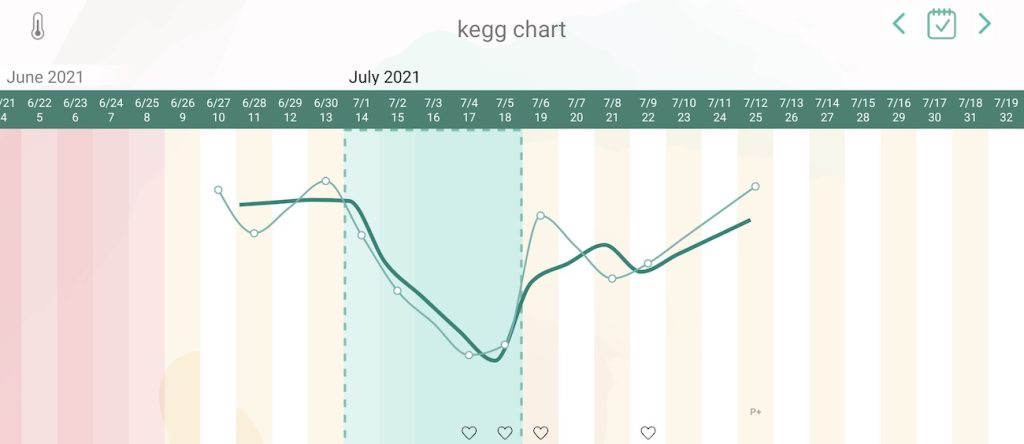Photo: Hernan Pauccara
Trigger Warning: This article discusses miscarriage and displays a pregnancy chart that end in loss.
While experiencing a miscarriage is common, as about 1 in 4 pregnancies ends is loss, we don’t often hear what to expect in the cycle after loss. Especially when you’re working through the challenging emotions associated with loss, being able to know what to expect during the next cycle can be helpful.
Miscarriages can happen anytime during the first twenty weeks of pregnancy, but most commonly occur within the first 12 weeks of pregnancy, with loss most frequently happening within the first six weeks. A biochemical pregnancy occurs when a woman tests positive for pregnancy with an hCG urine or blood test but there is no evidence of pregnancy on ultrasound. Many women may not realize that they have experienced a biochemical pregnancy as the period may arrive on time or a few days or more late, depending on how quickly the hCG and progesterone begin to decline.
With pregnancies that begin to develop in utero, the timing of loss can be highly variable. Some women will experience bleeding as the first sign of their loss (note: bleeding in pregnancy is common and does not necessarily indicate that a miscarriage will ensue). Others will experience a missed miscarriage, also known as a silent miscarriage when the pregnancy does not progress or the baby passes, but there is no indication of a problem, such as bleeding. While some women will naturally miscarry with spontaneous bleeding, others may require medication to induce a bleed or a surgery to remove what was inside the uterus associated with the pregnancy.
Miscarriages can happen anytime during the first twenty weeks of pregnancy, but most commonly occur within the first 12 weeks of pregnancy, with loss most frequently happening within the first six weeks. A biochemical pregnancy occurs when a woman tests positive for pregnancy with an hCG urine or blood test but there is no evidence of pregnancy on ultrasound. Many women may not realize that they have experienced a biochemical pregnancy as the period may arrive on time or a few days or more late, depending on how quickly the hCG and progesterone begin to decline.
With pregnancies that begin to develop in utero, the timing of loss can be highly variable. Some women will experience bleeding as the first sign of their loss (note: bleeding in pregnancy is common and does not necessarily indicate that a miscarriage will ensue). Others will experience a missed miscarriage, also known as a silent miscarriage when the pregnancy does not progress or the baby passes, but there is no indication of a problem, such as bleeding. While some women will naturally miscarry with spontaneous bleeding, others may require medication to induce a bleed or a surgery to remove what was inside the uterus associated with the pregnancy.
The Start of a New Cycle
The first day of bleeding associated with the pregnancy loss is considered cycle day 1 of the new cycle as the bleeding associated with the miscarriage is considered the period. While miscarriages are often heavy, the length of the period and heaviness of flow can vary and is influenced by how far along the pregnancy was before loss occured, the manner in which the pregnancy leaves the body (medical management, surgical management, or natural management).
The first cycle after loss is typically longer than usual. The follicular phase, or time between the start of the period and ovulation, is often prolonged as hormones regulate once again, while the bleeding itself can also last longer than typical. It is common for this first cycle to be 4-6 weeks in length, and can, more often, be anovulatory, or not successful for ovulation. After a loss, your health care provider can provide recommendations regarding when you can try to conceive once again. Some women are given the green light immediately, especially if the pregnancy loss was very early, such as a biochemical pregnancy, whereas others are advised to wait a certain duration of time or number of cycles.
The first cycle after loss is typically longer than usual. The follicular phase, or time between the start of the period and ovulation, is often prolonged as hormones regulate once again, while the bleeding itself can also last longer than typical. It is common for this first cycle to be 4-6 weeks in length, and can, more often, be anovulatory, or not successful for ovulation. After a loss, your health care provider can provide recommendations regarding when you can try to conceive once again. Some women are given the green light immediately, especially if the pregnancy loss was very early, such as a biochemical pregnancy, whereas others are advised to wait a certain duration of time or number of cycles.
Tracking your fertility with kegg
When your doctor allows you to resume kegg use, you may begin using kegg after the period ends. Since it is expected to experience a longer than typical cycle the first cycle after loss, if you begin using kegg during this cycle, you will want to keep an eye on your kegg readings, as the fertility prediction may not be accurate. As the fertile window opens, the kegg readings will descend on your kegg chart. When you see the readings move downwards, you can assume you are likely in this fertile window and, if you’re trying to conceive, this is when you should ideally time your efforts. As the readings rise after the initial descent, you can assume the fertile valley is coming to an end, as the rise that occurs at the completion of the valley is due to the shift to progesterone dominance.

The kegg chart above is the first cycle after the user experienced a loss at 8 weeks. She reported that bleeding was prolonged, when her period typically lasts 5 days, and in this cycle she experienced 8 days of flow. She resumed kegg used on cycle day 10. On cycle day 14 she noted that her reading appeared lower, so she began to suspect she was entering her fertile valley. The next lower readings confirmed this, although her partner was out of town so she was not able to time her efforts during these days. On cycle day 19 she recognized the rise in her kegg data and suspected her fertile valley had ended. Her fertile window is in a dashed border this cycle as he had many missed readings during this cycle. Despite this, her fertile valley is still apparent and she was able to identify it starting through its closure. She conceived this cycle but sadly experienced another loss.

In this cycle above, the user experienced an early pregnancy loss, and this chart reflects her first cycle after her miscarriage. While she experienced small fluctuations in readings, there is no obvious valley in her kegg data and her readings remain relatively flat. She confirmed that this cycle was anovulation, or not successful for ovulation, through both ultrasound and serum Progesterone testing. This is not an uncommon occurrence after loss when hormones are regulating after a loss.
Perhaps the most important component to resuming your fertility journey is recognizing that you are in charge. If you decide you would like to take some time off from trying to conceive, the choice is yours! When and if you feel ready (and cleared by your doctor) to resume your efforts, you have the tools to help you see the fertile window and optimally time your efforts.
Perhaps the most important component to resuming your fertility journey is recognizing that you are in charge. If you decide you would like to take some time off from trying to conceive, the choice is yours! When and if you feel ready (and cleared by your doctor) to resume your efforts, you have the tools to help you see the fertile window and optimally time your efforts.
In honor of National Infertility week, you can book your fertility consultation for $50 off. This means you can have a personalized 1:1 visit with Dr. Levy to discuss your concerns and goals, health history, and plan of care for only $100. Book your consultation here using code “kegg50” at the checkout.
* offer valid until 5/15/22
